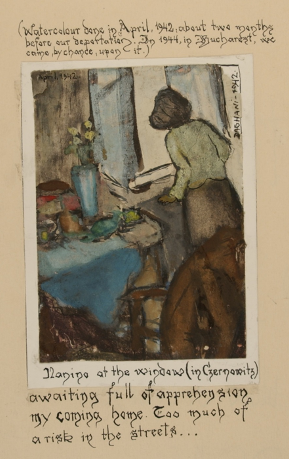Nanino At The Window

Painting by Arnold Daghani • Sussex German Jewish Archives
This 1942 painting by Arnold Daghani comes from the Centre for German-Jewish Studies at the University of Sussex. Set in Bucharest, it shows the painter’s wife waiting anxiously at the window for him to come home.
Arnold Daghani (1909-1985) came from a German-speaking Jewish family in Suczawa, in the Bukowina, then on the eastern borders of the Austro-Hungarian Empire, now Suceava in Romania.
In June 1942 Daghani and his wife Anisoara (whom he called Nanino) were deported to the slave labour camp of Mikhailowka (south west Ukraine), from where they managed to escape in July 1943 only a few months before the camp was liquidated. Daghani’s narrative of events at Mikhailowka was published in Romanian (1947), German (1960) and in English as The Grave is in the Cherry Orchard (1961).
In 1958 the Daghanis left Romania, emigrating to Israel (1958-59), France (1960-70), Switzerland (1970-77) and finally England (1977-85), settling in Hove, near Brighton.
In 1987 the Arnold Daghani Trust donated a substantial collection of around 6,000 works to the University of Sussex. The collection was catalogued, thanks to a generous donation from The Ian Karten Trust, as part of a project within the Centre for German Jewish Studies.
The collection contains many of the complex and elaborate albums of drawings, paintings and writings documenting Daghani’s experiences in Mikhailowka and the ghetto at Bershad, such as What a Nice World and 1942 1943 And Thereafter (Sporadic records till 1977). These albums include original watercolours Daghani made secretly at this time.
The collection contains many drawings and writings from the period 1944 to 1958 when Daghani and Anisoara were living in Bucharest and Israel. These are particularly indicative of Daghani’s interest in religion, with many works representing Christian and Jewish subjects, often depicted in ink line drawings. Works from this period also deal with Daghani’s artistic reception, both in Romania in relation to Socialist Realism, and in the ‘Free World’ of Israel. Short stories give accounts of living conditions at the time, and images record everyday life. Daghani’s experiences and difficulties of emigration are recorded in both images and writings.
Discover more Hidden Treasures
Hidden Treasures: Celebrating the documents, photos and artefacts in British archives that tell the story of Jews in Britain